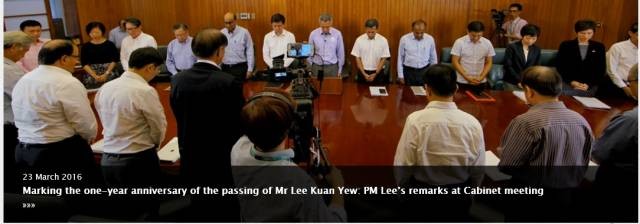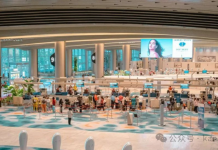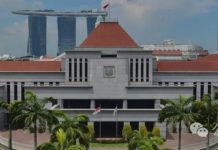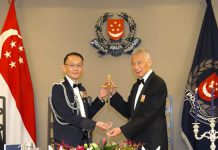今天是纪念李光耀逝世一周年的日子,李显龙总理下午与内阁成员集体追思建国总理,并发表动情演讲。
以下是演讲全文。
中文
同事们,
一年前的今天,李光耀先生去世了。之后那一周的全国哀悼已成为我们建设与发展新加坡认同感的一个里程碑。
光阴似箭,日月如梭,今天是他逝世后的第一个周年。
我们纪念这一天,是为了纪念他的一生,并展望未来。遍布新加坡的诸多团体都举办各种活动来纪念他的价值和他一生的成就。我们都在重新把自己奉献给李先生毕生热爱的新加坡。
在我们开始今天的内阁会议之前,我们先花一来点时间来怀念李先生和他多年来所做出的一切,尤其是在这个房间里。
人民行动党在1959年开始执政,原来的总理办公室是在市政厅。1971年,李先生把他的办公室搬到了总统府,而这个房间就成为内阁会议室。40年来,李先生每个星期都在这里主持或参与内阁会议,讨论当天的问题并作出影响新加坡走向的决定。
华语有句话,叫做“运筹帷幄之中,决胜千里之外”。意思是说,将领坐在军营里,为千里之外的军队策划战略和计划。这个内阁会议室就是李先生的指挥部,是分析和讨论问题、作出决定、发出指令和跟踪进度的地方。
这是一个集体的努力。李先生是团队的领头羊,而所有的部长们都积极参与内阁讨论。很多人都知道李先生的公众形象——他的领导风格,他处理问题的方法,以及他的成就。但很少人有像他的内阁同事能够直接与他共事的荣幸,能够像我们这里很多人一样亲身体验他如何运行他的内阁与政府。那是一个开放、互动和动态的过程,对于所有参与过的人来说,都是一次难忘的经历。
李先生通常会对讨论的问题提出明确的意见。他会叙述历史,以及为什么我们会面临现在的情形,以便让我们在做出新的决定时了解来龙去脉。他比较在意的是,如果要拆掉一个篱笆,必须先了解当初为什么会修那个篱笆。虽然他经常会直接表达自己的观点,但也会鼓励有着不同意见的部长们来为他们的观点辩护,并保持开放的态度听取他们的意见。
令我记忆深刻的一个例子,是我们在1985年削减公积金缴交费的决定。在快速增长的阶段,李先生已经非常系统地建立了中央公积金费用,最终把它提升到工资的50%。他以他一贯稳健的方式与主张降低公积金来降低成本的批评者进行辩论。之后,我们遭遇严重的经济衰退。我主持的经济委员会最终的结论是,费用的确过高,我们确实需要扭转政策,削减公积金费用来使经济重新具有竞争力。陈庆炎博士是当时的贸易和工业部长,他也赞同这个观点。MTI提出了一个内阁文件,提出把公积金缴交率从50%降低至40%。
李先生听了我们的观点。令我们惊讶的是,他说如果你们要做就做得干脆,40%不伦不类的,干脆直接降低到35%。另外,只削减雇主的费用,不要削减员工的费用,这样他们收入可以多一些。这是一剂苦药,我们当时努力说服工会和工人。但它的确有效,让我们走出了经济衰退,并迅速创造了工作机会。对于比较年轻的部长们和大众来说,这是一个重要的经验。我们不只是在经济管理方面,而且在政治领导方面都吸取了教训。
作为总理,李先生一直对于新加坡的各个方面明察秋毫,无论是我国经济的健康,我们的外交状况,还是东海岸公园大道的树木,以及新加坡河的清洁等等。他没有对任何事情掉以轻心。
但他知道他不能亲自控制一切,而另一位总理将会用不同的方式来管理。他引用毛泽东的话,“十个手指按住十个跳蚤,一个也抓不住”,告诉人们不得不专注于重要的事情,并建立一个团队。
他本人作出了巨大的努力以确保他的继任者能够成功。即使在他辞去总理之职后,他继续以高级部长以及后来内阁资政的身份参加内阁会议。最引人注目的是,三代更年轻的部长们都从他的经验、见解、观点、关切以及他为新加坡的未来的思考中获益。因此,近半个世纪以来,在这个房间里所进行的讨论以及所做出的决定在全世界的内阁中都是出类拔萃的。
现在,我们是一个新的团队,在以新的方式应对一个变化了的世界,但一直被李先生的榜样和对他的怀念所启发,也秉持着他代表和支持的坚定的民族精神和价值观。这将指导我们追逐李先生追逐了一生的彩虹——打造一个优秀杰出的国家,以改善所有新加坡人的生活。
我们有太多需要感谢他的地方,现在我请大家起立,共同默哀一分钟。
(译文由风铃提供)
英文
Colleagues,
One year ago today, Mr Lee Kuan Yew passed away. The week of national mourning that followed was a landmark in our nation building, and in developing a Singapore identity.
Time passes quickly, and now we are at the first anniversary.
We are marking this day by celebrating Mr Lee’s life and looking forward. Many groups all over Singapore are holding events to commemorate his values and his life work. We are all rededicating ourselves to Mr Lee’s lifelong passion – Singapore.
As we begin our Cabinet meeting today, let us take a moment to remember Mr Lee and what he stood for and did over the years, especially in this very room.
The PAP came into power in 1959. At first, the Prime Minister’s Office was at the City Hall. In 1971, Mr Lee moved his office to the Istana. Cabinet meetings were held in this room. Every week for 40 years, Mr Lee chaired or attended Cabinet here to discuss the issues of the day, and make decisions that set the course for Singapore.
There is a Chinese saying “运筹帷幄之中,决胜千里之外”. The general sits in his command tent, devising strategies and plans that bring his armies victory a thousand miles away in the field. This Cabinet Room was Mr Lee’s command tent, where issues were examined and debated, decisions were taken, instructions given, and progress tracked.
This was a collective endeavour. Mr Lee was primus inter pares – first among equals. But the Ministers took active part in Cabinet deliberations. Many know Mr Lee’s public face – his leadership style, his approach to problems, his record of achievements. But few have had the privilege of his Cabinet colleagues, including quite a number of us here today, who worked directly with him, and experienced up close how he ran his Cabinet and Government. It was an open, interactive, dynamic process, an unforgettable experience for all those who participated in it.
Mr Lee would usually have clear views on the matter under discussion. He would recount the history and the considerations that led us to where we were, so that we kept sight of the context as we made fresh decisions. He was mindful that before removing the fence, one had to understand why it had been put there in the first place. Though he often gave his views up front, he would encourage Ministers with different views to argue their case, and listen to them with an open mind.
One example I remember well was our decision to cut CPF contributions in 1985. During a phase of rapid growth, Mr Lee had systematically built up CPF contributions, eventually raising them to 50% of wages. He had defended this in his usual robust way, against critics who wanted to reduce the CPF to cut costs. Then we ran into a severe recession. I chaired the Economic Committee, which eventually concluded that costs had got out of line, and that we did indeed need to reverse policy, to cut the CPF to make the economy competitive again. Dr Tony Tan was the Minister for Trade and Industry, and he agreed. MTI put up a Cabinet paper proposing to cut the CPF contribution rate from 50% to 40%.
Mr Lee listened to our arguments. Then to our surprise he said if you are going to do it, do it properly. 40% is neither here nor there. Make a decisive move, and cut it to 35%. Furthermore, cut only the employer’s contributions. Do not cut employees’ contributions to increase take home pay. That may sweeten the package, but it will do nothing to make us more competitive. It was bitter medicine, and we had to work hard to sell it to the unions and workers. But it worked, brought us out of the recession and brought jobs back quickly. It also was an important bonding exercise and experience for the younger ministers and the population. We learnt a lesson not just in economic management but in political leadership.
As Prime Minister, Mr Lee kept an eagle’s eye on every aspect of Singapore, whether it was the health of our economy, the state of our foreign relations, the trees along the East Coast Parkway, or the cleanliness of the Singapore River. He left nothing to chance.
And yet he knew that he could not control everything personally, and that even more so another Prime Minister would have to govern in a different way. He advised us that one could not use ten fingers to catch ten fleas, quoting Mao. One had to focus on the important things and build a team.
He himself made an enormous effort to ensure that his successors succeeded. Even after he stepped down as Prime Minister, he continued to attend Cabinet meetings as Senior Minister and later as Minister Mentor. Most remarkably, three generations of younger ministers benefitted from his experience and insights, his views and concerns, and increasingly his thoughts for Singapore’s future. So for nearly half a century, here in this room, we had a level of discussion and decision-making that would have been exceptional in any Cabinet room in the world.
Now we are a new team, dealing with a changed world in new ways, but always inspired by Mr Lee’s example and his memory, and holding firm the ethos and values that he stood and fought for. These will guide us as we in our turn follow the rainbow that Mr Lee himself chased all his life – to build an exceptional nation and to improve the lives of all Singaporeans.
We have so much to be grateful for. Now I invite you to rise, and observe a minute of silence together.










